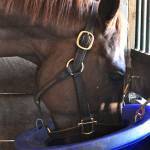Gastric Ulcers in Horses: Beet Pulp as Prevention?

Any horse can develop gastric ulcers—painful erosions of the stomach lining that contribute to weight loss, poor performance, irritability, and colic. Despite intense study of equine gastric ulcer syndrome (EGUS) in horses, failsafe management strategies have yet to be identified. One recent study on EGUS in warmbloods* reported that horses offered beet pulp had a lower risk of developing ulcers in the squamous part of the stomach.
Gastric ulcers occur either in the glandular part of the stomach that produces gastric fluid or the squamous or nonglandular portion. Ulcers in the glandular region are referred to as equine glandular gastric disease (EGGD), while ESGD refers to ulcers in the squamous region.
Based on the most up-to-date data, primarily derived from performance horses with ESGD, some ways to potentially help prevent or manage the syndrome include:
- Offer as much fiber or forage as possible. Consider using alfalfa (lucerne) hay, as it contains natural buffers, for horses that require the energy it provides;
- Avoid prolonged periods without forage (e.g., during transport and overnight);
- Use low-starch feeds whenever possible.
- Introduce a high-fat supplement, such as stabilized rice bran, in lieu of larger amounts of starch. Stabilized rice bran reduces acid secretion and increases output of prostaglandins that help protect the stomach lining;
- Allow pasture turnout as much as possible, even if a grazing muzzle needs to be used; and
- Ensure horses have access to water at all times.
To gain more insight into EGUS in sport horses a group of Canadian researchers examined and collected management histories on 83 Warmbloods in training or competition.
Frequency and intensity of exercise increased the odds of EGUS, which was not revelatory to researchers. “Surprising to some, however, was that horses offered beet pulp had a decreased risk of ESGD,” said Kathleen Crandell, Ph.D., a nutritionist for Kentucky Equine Research.
The research team explained, “There are no studies on the effects of beet pulp on gastric physiology in horses, but beet pulp may provide an alternative or additional fiber source that may influence production of saliva, gastric pH, or gastric microbiota.”
Beet pulp, frequently classified as a “super fiber” because it contains more energy than typical fiber sources such as forage, is usually soaked before offered to horses, though soaking is not necessary. This product can be mixed in with a horse’s normal grain ration or fed by itself after a gradual introduction.
Need help learning how to introduce beet pulp into your horse’s diet? Contact a Kentucky Equine Research nutrition advisor today.
“In addition to consultation, Kentucky Equine Research offers several products to support gastrointestinal health, including RiteTrac, which quickly neutralizes excessive gastric acid, protecting the stomach lining and restoring the normal gastric environment,” advised Crandell.
Look for these research-proven products in Australia.
*Pedersen, S.K., A.E. Cribb, M.C. Windeyer, et al. Risk factors for equine glandular and squamous gastric disease in show jumping Warmbloods. Equine Veterinary Journal. In press.








